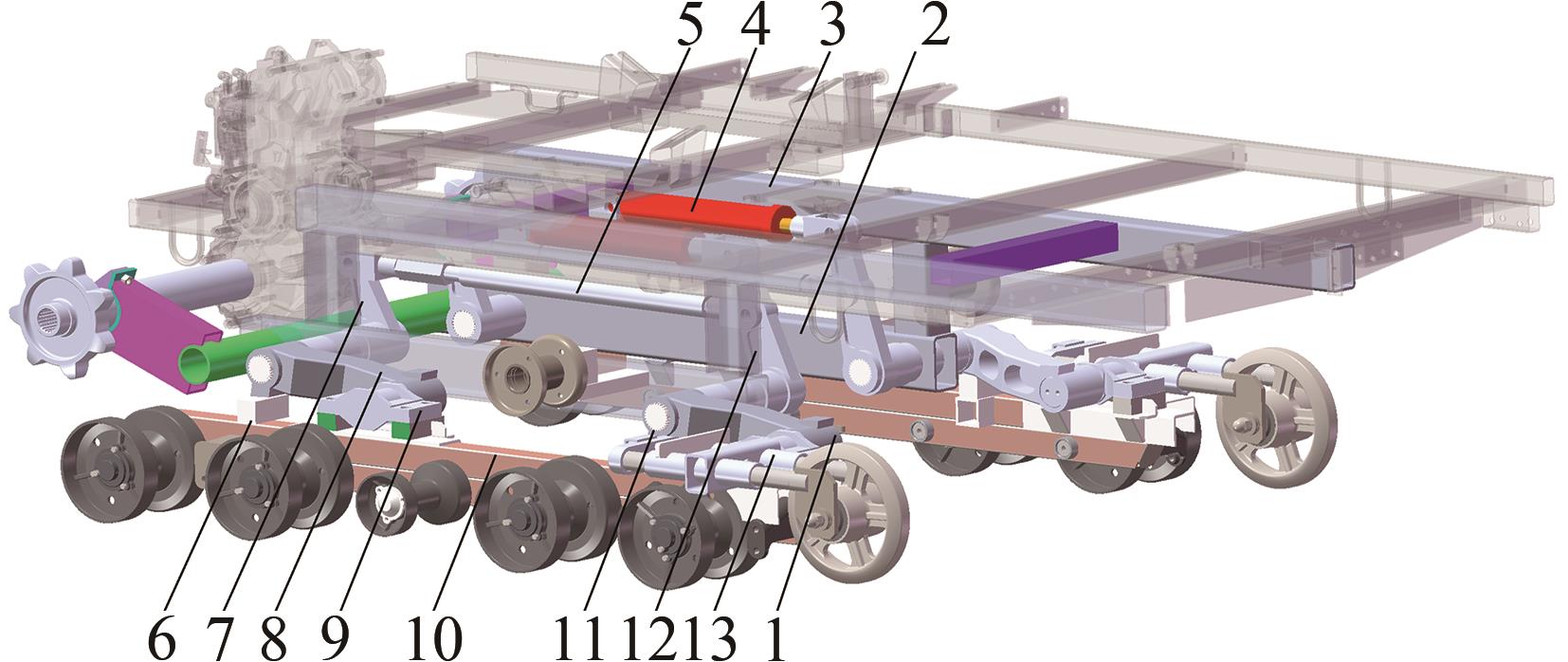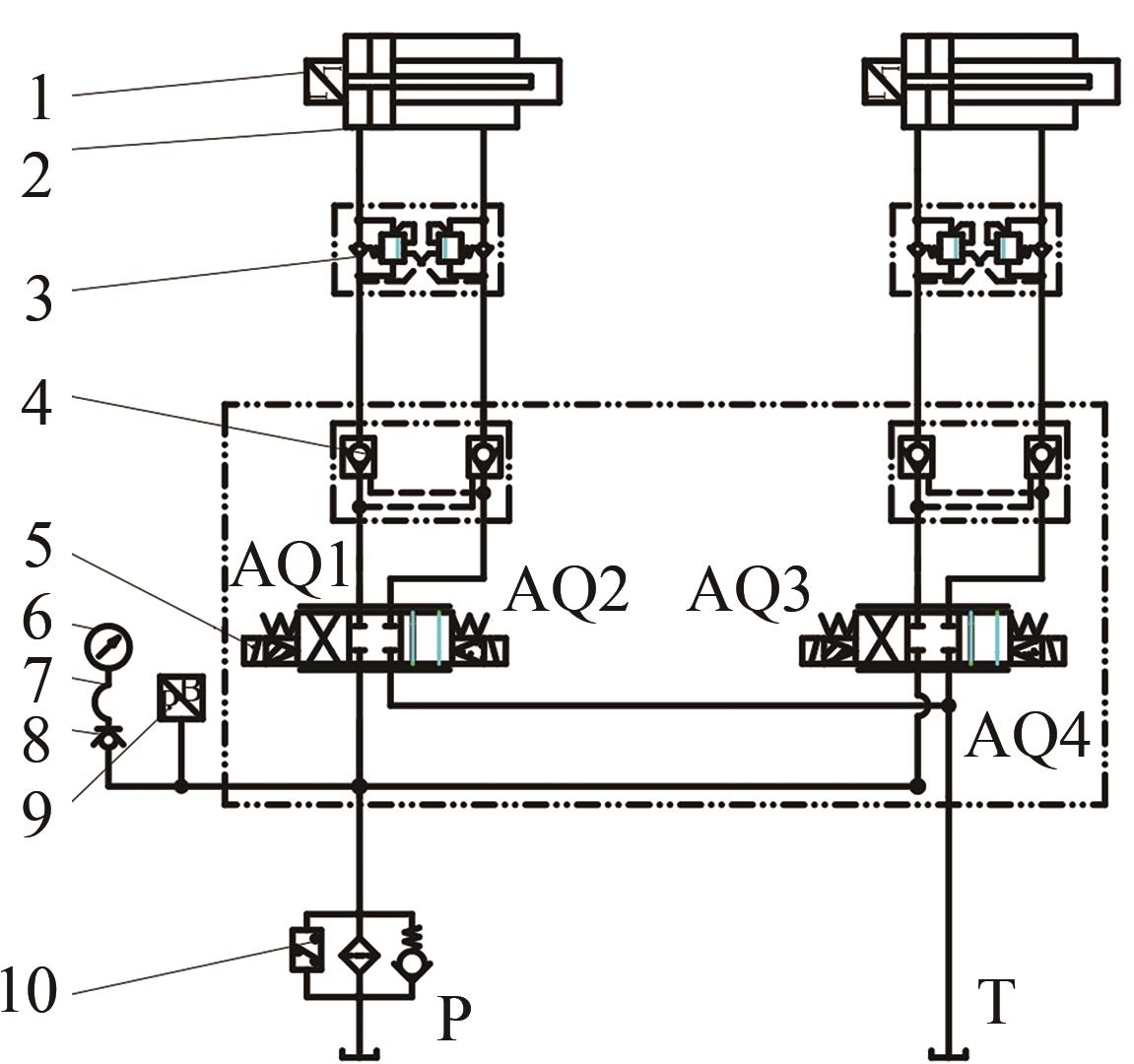Journal of Intelligent Agricultural Mechanization ›› 2025, Vol. 6 ›› Issue (1): 59-70.DOI: 10.12398/j.issn.2096-7217.2025.01.006
Previous Articles Next Articles
YANG Ke1,2( ), LI Ju1,2, CHEN Yu1,2, LI Hao3, AO Yu4, LEI Xiaolong1,2(
), LI Ju1,2, CHEN Yu1,2, LI Hao3, AO Yu4, LEI Xiaolong1,2( )
)
Received:2024-07-16
Revised:2024-08-30
Online:2025-02-15
Published:2025-02-15
Corresponding author:
LEI Xiaolong
About author:YANG Ke, Master's degree candidate, research interests: liftable chassis for rice harvester. E-mail: 2022317023@stu.sicau.edu.cn
Supported by:CLC Number:
YANG Ke, LI Ju, CHEN Yu, LI Hao, AO Yu, LEI Xiaolong. Design and testing of a liftable chassis for rice harvester[J]. Journal of Intelligent Agricultural Mechanization, 2025, 6(1): 59-70.
Add to citation manager EndNote|Ris|BibTeX
URL: http://znhnyzbxb.niam.com.cn/EN/10.12398/j.issn.2096-7217.2025.01.006

Figure 1 Structure of the lifting chassis1. Rear lifting arm 2. Middle beam 3. Chassis frame 4. Hydraulic cylinder 5. Connecting rod 6. Limit block 7. Front swing arm8. Front lifting arm 9. Front hinge support 10. Traveling device11. Splined shaft 12. Rear swing arm 13. Rear hinge support

Figure 8 Hydraulic control schematic diagram.1. Hydraulic cylinder 2. Magnetic displacement sensor 3. Two-way balancing valve 4. Hydraulic lock (one-way valve) 5. Proportional directional valve 6. Shock-resistant pressure gauge 7. Pressure measuring hose 8. Pressure measuring joint 9. Pressure sensor 10. High-pressure filter
| 1 | WEI Zhongcai, WANG Xinghuan, LI Xueqiang, et al. Design and experiment of crawler self-propelled sorting type potato harvester [J]. Transactions of the Chinese Society of Agricultural Machinery, 2023, 54(2): 95-106. |
| 2 | JIN Chengqian, YANG Tengxiang, LIU Gangwei, et al. Design and test of posture controlled chassis for caterpillar combine [J]. Transactions of the Chinese Society for Agricultural Machinery, 2020, 51(11): 393-402. |
| 3 | SUN Yixin, XU Lizhang, JING Bo, et al. Development of a four-point adjustable lifting crawler chassis and experiments in a combine harvester [J]. Computers and Electronics in Agriculture, 2020, 173. |
| 4 | HU Jinpeng, PAN Jiahui, DAI Buwang, et al. Development of an attitude adjustment crawler chassis for combine harvester and experiment of adaptive leveling system [J]. Agronomy, 2022, 12(3): 717-717. |
| 5 | SUN Jingbin, MENG Chong, ZHANG Yazhou, et al. Design and physical model experiment of an attitude adjustment device for a crawler tractor in hilly and mountainous regions [J]. Information Processing in Agriculture, 2020, 7(3): 466-478. |
| 6 | JING Bo, XU Lizhang. Design and simulation of liftable crawler chassis for combine harvester [J]. Journal of Advances in Agriculture, 2018, 8: 1476-1487. |
| 7 | GUAN Zhuohuai, ZHANG Min, JIN Mei, et al. Research progress of mechanical damage to soil by walking mechanism of tracked agricultural equipment [J]. Journal of Intelligent Agricultural Mechanization, 2022, 3(1): 62-70. |
| 8 | JANG M K, HWANG S J, KIM J H, et al. Overturning and rollover characteristics of a tractor through dynamic simulations: Effect of slope angle and obstacles on a hard surface [J]. Biosystems Engineering, 2022, 219: 11-24. |
| 9 | RONDELLI V, CASAZZA C, MARTELLI R. Tractor rollover fatalities, analyzing accident scenario [J]. Journal of safety research, 2018, 67: 99-106. |
| 10 | LI Z, MITSUOKA M, INOUE E, et al. Parameter sensitivity for tractor lateral stability against Phase I overturn on random road surfaces [J]. Biosystems engineering, 2016, 150: 10-23. |
| 11 | SONG Y, ZHANG X, WANG W. Rollover dynamics modelling and analysis of self-propelled combine harvester [J]. Biosystems Engineering, 2021, 209: 271-281. |
| 12 | YOON J, CHO W, KANG J, et al. Design and evaluation of a unified chassis control system for rollover prevention and vehicle stability improvement on a virtual test track [J]. Control Engineering Practice, 2010, 18(6): 585-597. |
| 13 | VERMILLION C, SUN J, BUTTS K. Modeling, control design, and experimental validation of an overactuated thermal management system for engine dynamometer applications [J]. IEEE transactions on control systems technology, 2008, 17(3): 540-551. |
| 14 | BADGUJAR C, FLIPPO D, WELCH S. Artificial neural network to predict traction performance of autonomous ground vehicle on a sloped soil bin and uncertainty analysis [J]. Computers and Electronics in Agriculture, 2022, 196: 106867. |
| 15 | FRANCESCHETTI B, RONDELLI V, CIUFFOLI A. Comparing the influence of Roll-Over protective structure type on tractor lateral stability [J]. Safety science, 2019, 115: 42-50. |
| 16 | AHMADI I. Dynamics of tractor lateral overturn on slopes under the influence of position disturbances (model development) [J]. Journal of Terramechanics, 2011, 48(5): 339-346. |
| 17 | ZHU Y, KAN J. Prediction of the lateral stability of a forestry chassis with an articulated body and fitted with luffing wheel-legs [J]. Biosystems Engineering, 2022, 224: 143-160. |
| 18 | HAS Z, RAHMAT M F, HUSAIN A R, et al. Robust position tracking control of an electro-hydraulic actuator in the presence of friction and internal leakage [J]. Arabian Journal for Science and Engineering, 2014, 39: 2965-2978. |
| 19 | ZHANG Zhaoguo, WANG Yichi, LI Hanqing, et al. Design and test of hydraulic control tracked self-propelled greenhouse panax notoginseng harvester [J]. Transactions of the Chinese Society of Agricultural Machinery 2021, 52(6): 127-135, 158. |
| 20 | JIAO X, XIE J, WANG X, et al. Intelligent decision method for the position and attitude self-adjustment of hydraulic support groups driven by a digital twin system [J]. Measurement, 2022, 202: 111722. |
| 21 | GE X, XIE J, WANG X, et al. A virtual adjustment method and experimental study of the support attitude of hydraulic support groups in propulsion state [J]. Measurement, 2020, 158: 107743. |
| 22 | HU L, GAO H, LIU Z, et al. Configuration design and kinematic performance analysis of a parallel wheelset suspension for a multi-wheeled pressurized lunar rover [J]. Acta Astronautica, 2024, 217: 162-180. |
| 23 | DETTÙ F, CORNO M, D'AMBROSIO D, et al. Modeling, control design and experimental automatic calibration of a leveling system for combine harvesters [J]. Control Engineering Practice, 2023, 132: 105411. |
| 24 | DU Xiaoqiang, NING Chen, YANG Zhenhua, et al. Design and experiment of hydraulic system for crawler chassis of straddle type camellia oleifera fruit harvester [J]. Transactions of the Chinese Society of Agricultural Machinery 2023, 54(3): 139-147. |
| 25 | SUN Xiaoqiang, CAI Yignfeng, YUAN Chaochun, et al. Fuzzy sliding mode control for the vehicle height and leveling adjustment system of an electronic air suspension [J]. Chinese Journal of Mechanical Engineering, 2018, 31(2): 238-250. |
| 26 | JIANG Y, SUN Z, WANG R, et al. Design and control of a new omnidirectional levelling system for hilly crawler work machines [J]. Computers and Electronics in Agriculture, 2024, 218: 108661. |
| 27 | FENG Y, TIAN X, LI T, et al. Measurement of mobile manipulator chassis pose change caused by suspension deformation and end-effector accuracy improvement based on multi-sensor fusion [J]. Robotics and Autonomous Systems, 2023, 170: 104553. |
| 28 | ZHAO Zhiyu, ZHU Licheng, ZHOU Liming, et al. Design and experiment of chassis control system for weeding robot in hilly orchard [J]. Transactions of the Chinese Society for Agricultural Machinery, 2022, 53, 48-57. |
| 29 | ZHAO Weisong, CHEN Yongsheng, WANG Zhenwei, et al. Design and experimental verification of conveying device for crushed cornstalks [J]. Journal of Intelligent Agricultural Mechanization (in Chinese and English), 2021, 2(1): 1-12. |
| 30 | ZHU Zhengbo, CAO Xin, ZHANG Ruihong. Optimal design of garlic clove's orientation adjustment system based on parallel robot [J]. Journal of Intelligent Agricultural Mechanization, 2023, 4(4): 20-25. |
| 31 | LEI Xiaolong, CHEN Yu, YANG Ke, et al. Design and experiment of chassis automatic lifting hydraulic system for harvester [J]. Journal of Intelligent Agricultural Mechanization, 2024, 5(2): 9-18. |
| [1] | CHEN Xu, HE Xun, ZHU Chenhui, WANG Baoshan, WANG Wanzhang. Research status and development trend of feed quantity detection technology for grain combine harvester [J]. Journal of Intelligent Agricultural Mechanization, 2025, 6(1): 71-80. |
| [2] | LEI Xiaolong, CHEN Yu, LI Ju, YANG Ke, LIU Cheng, YU Xiangyang. Design and experiment of chassis automatic lifting hydraulic system for harvester [J]. Journal of Intelligent Agricultural Mechanization, 2024, 5(2): 9-18. |
| Viewed | ||||||
|
Full text |
|
|||||
|
Abstract |
|
|||||
